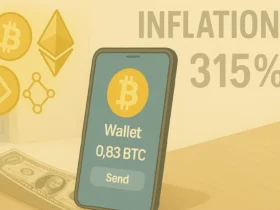In this article, I will highlight the Best Crypto Bridges for Fast Transactions Between Blockchains for quick, safe, and economical transfers of digital assets across various networks.
These crypto bridges promote interoperability, enabling the frictionless transfer of tokens across Ethereum, BNB Chain, Polygon, and Avalanche blockchains, thereby reducing costs and the duration of transactions for an enhanced DeFi experience.
Key Points & Best Crypto Bridges For Fast Transactions Between Blockchains
Defiway Bridge: Fast, low-fee transfers across major chains like Ethereum, BNB Chain, and Polygon.
Portal Bridge (Wormhole): Decentralized and secure bridge connecting Solana, Ethereum, and other top blockchains.
Synapse Protocol: Supports 15+ chains with rapid cross-chain swaps and strong liquidity pools.
Multichain (Anyswap): Interoperability powerhouse with support for 90+ blockchains and high-speed transfers.
LayerZero: Omnichain messaging protocol enabling ultra-fast and secure cross-chain communication.
Across Protocol: Optimized for Ethereum Layer 2 transfers with near-instant finality and low fees.
Stargate Finance: Unified liquidity and native asset transfers across chains with fast settlement.
Celer cBridge: Low-cost, high-speed bridging across Ethereum, Avalanche, BNB Chain, and more.
Allbridge: Cross-chain support for both EVM and non-EVM chains like Solana and Terra.
Hop Protocol: Specialized in fast bridging between Ethereum Layer 2s like Arbitrum and Optimism.
10 Best Crypto Bridges For Fast Transactions Between Blockchains
1. Defiway Bridge
Defiway Bridge positions itself as a fast, low-cost option for cross-chaining transfers. It also supports most EVM and some non-EVM (e.g. TRON) networks as well.
They guarantee “ultimate speed, minimal cost and enhanced security” during transfers (e.g. USDT transfers during cross Ehereum and Solana).

The bridge even boasts the most comprehensive source and destinatin options as well as removal of the typical approval transactions.
For those looking for a simple and quick bridging solution with expansive network, Defiway is among the most rapid options available. However, like any bridge, check for current pricing, available tokens, and security.
Features Defiway Bridge
- Ultra-Fast Transfers: Instant cross-chain swaps between major EVM and non-EVM chains, including Ethereum, BSC and TRON.
- Low Fees: Transactions with minimized costs and optimized liquidity routing.
- High Security: Protects user funds with multi-sig wallets and strong enfcryption.
- Wide Token Support: Flexible transfers with popular stablecoins and versatile tokens
2. Portal Bridge
Portal Bridge allows for inter-chain token and NFT transfers within the Wormhole ecosystem. There is a locking minting mechanism for each chain.
Each transaction is managed and validated by a “guardian” node Designed for “unlimited” transfers, it handles multiple EVM and non-EVM chains.

For users needing less-common chains and NFT cross-chain movement, Portal Bridge is a viable option.
Supported asset pairs and any rounding or liquidity limitations should be double-checked, as is the case in all such systems.
Features Portal Bridge (Wormhole)
- Multi-Chain Connectivity: Bridge assets between Ethereum, Solana, BSC, Polygon and more.
- NFT Transfers: Cross-chain transfers of fungible tokens and NFTs.
- Decentralized Guardians: Protects passes from editing and uses verified nodes to confirm passes.
- User-Friendly Interface: Simple asset transfers via a streamlined dashboard.
3. Synapse Protocol
Synapse Protocol, designed with a focus on cross-chain interoperability, lets users interact with more than 20 EVM and non-EVM chains, as well as execute transfers, swaps and leave messages across chains.
It gives the option and flexibility to cross chains with adjustments to smart contracts and assets.. For users who wish to have something more than simple token transfers

Which is the focus for a lot of users, it allows more complex DeFi flows to be achieved across chains.
On the downside, users should monitor the supported token pairs, as the system is designed in a more general sense. In each chain the interface is smooth, but the finality times should be checked on.
Features Synapse Protocol
- Universal Interoperability: 20+ chains for tokens and for swaps and smart contract data.
- Low Latency: Near-instant cross-chain confirming using cross-chain messaging.
- DeFi Integration: Liquidity pool bridge and cross-chain automation in DeFi.
- Secure Architecture: Smart contracts are audited regularly and exploits are prevented.
4. Multichain
Multichain (previously known as Anyswap) has been providing cross-chain routing services for the longest time. In fact, they service the most blockchains and tokens.
By offering “1:1 bridges”, they state that they eliminate slippage—caused by wrapped assets—by transporting native assets as opposed to carrying heavily wrapped assets.

If you are a user using multiple chains and you are looking for a focused option for your transfers, Multichain should be the first option you consider.
One thing to keep in mind is to always monitor the routing, slippage and liquidity for transfers to help avoid potential slippage.
Features Multichain (Anyswap)
- Massive Chain Coverage: Provides inclusive automatic multi-chain routing for over 70 blockchains.
- 1:1 Asset Transfers: Allows movement of native tokens without excessive wrapping or slippage.
- Stable: Unshakable since 2020 with reliable infrastructure and volume of billions.
- Cross-Chain Router: Automatically discovers the safest and most efficient route for your transfers.
5. LayerZero
LayerZero is inherently an interoperability protocol and not a cross-chain bridge user-interface. It serves as a cross-chain communications layer for a variety of new cross-chain technologies.
It offers trustless messaging and blockchain transfers seamlessly and lets bridge and cross-chain apps be built on it. An example would be Stargate Finance, built on LayerZero.

For the most part, the average person will use an app built on LayerZero. For example, Developers using LayerZero technologies will implement the most advanced cross-chain capabilities on their apps for LayerZero end-users
While everyday users will bridge crypto using an app built on LayerZero. It value comes from enhanced reliability, lower latency, and stronger security for cross-chain messaging.
Features LayerZero
- Omnichain Protocol: Offers the most rapid and secure route for cross-chain messaging.
- Developer-Friendly: dApps bridge and DeFi tools.
- Low Latency Messaging: The instantaneous messaging of data and value transfers between chains.
- Near Real-Time Messaging: Data moves between chains and tokens are transferred in seconds.
6. Across Protocol
Across Protocol calls itself an “intents-based” cross-chain bridge: instead of users having to explicitly define every step, you just state what you wish (e.g., “send X token from Chain A to Chain B”), and relayers take care of the rest swiftly.
They report extremely low cost (in many situations under US$1) and execution times under one minute. Across appeals to users with basic and straightforward transfer needs who wish speed and minimal friction.

Yet, like any new design pattern (intents + relayers), we recommend confirming availability for your specific token/chain and checking relayer fees or slippage.
Features Across Protocol
- Intent-Based Transfers: Users declare “what” they desire and relayers complete the transfer.
- Fast Settlements: Most transfers are completed in under one minute.
- Low Gas Fees: Gas fees are optimized to incur less cost than traditional bridges.
- Reliable Relayers: An incentivized system guarantees free relayers and constant availability of liquidity.
7. Stargate Finance
Stargate Finance is a LayerZero cross-chain bridge that provides native asset functionality. Liquidity is unified, and with no wrapped tokens needed, it provides efficient bridging to native assets.
It is reported to provide “instant, secure movement” to over 70+ blockchain assets. If users are looking to bridge native tokens with strong liquidity, one of the first options to consider is Stargate.

However, users should verify the bridge in regards to range and complexity. Complexity in track verification includes mesh of supported asset chains in the route and the expected fee to cost. (Reported fee complexity missing, low fees expected Srgtace)
Features Stargate Finance
- Native Asset Transfers: Transfers tokens directly and no wrapped assets are required.
- Unified Liquidity Pools: The speed of transactions is heightened and slippage is lessened.
- LayerZero Powered: LayerZero is utilized for secure and rapid interoperability.
- Cross-Chain DeFi: Users can perform staking, farming, and swaps across 70+ disbursed networks.
8. Celer cBridge
Celer’s cBridge is a multi-chain bridge built to provide fast, non-custodial transfers across 40+ chains and Layer 2 rollups. Using the “xAsset” (lock & mint) and “xLiquidity” (pool model) modes, it provides flexibility depending on the token/chain.
Users bridging across multiple chains (including non-EVMs or rollups) and looking for flexible transfer/pool cBridge is a strong choice.

One additional note is that flexibility of the model route is dependent on the model. Hence, liquidity or withdrawal flexibility may vary.
Features Celer cBridge
- Multi-Mode Bridging: Options for liquidity pool and lock-mint transfer are available.
- High Performance: Transfers are made in seconds across more than 40 chains and rollups.
- Non-Custodial Design: Users have full control over their assets.
- Robust Ecosystem: Integrations with numerous global DeFi and dApp environments.
9. Allbridge
Allbridge Core zeroes in on stablecoins and native-liquidity pools with no wrapping. It accommodates both EVM and non-EVM blockchains and emphasizes “bridge without wrapped tokens.”
As far as stablecoin (e.g. USDC, USDT) users is concerned, crossing different networks, simple and stable routes, and not exotic token corridors is what Allbridge is good for.

However, for more advanced financial products and rare tokens, confirm availability and supported chains.
Features Allbridge
- Stablecoin-Focused: Bridging USDT and USDC is of primary focus.
- Cross-EVM & Non-EVM Support: Compatible with Solana, Polygon, and BSC among others.
- No Wrapped Tokens: Transfers are made with native liquidity, ensuring no wrapped tokens and full transparency.
- Low Transaction Fees: Everyday use for cross-chain is designed to be economically feasible.
10. Hop Protocol
Allbridge Core zeroes in on stablecoins and native-liquidity pools with no wrapping. It accommodates both EVM and non-EVM blockchains and emphasizes “bridge without wrapped tokens.

As far as stablecoin (e.g. USDC, USDT) users is concerned, crossing different networks, simple and stable routes, and not exotic token corridors is what Allbridge is good for.
However, for more advanced financial products and rare tokens, confirm availability and supported chains.
Features Hop Protocol
- L2-Optimized: Designed for use on layer-2 Ethereum networks like Arbitrum and Optimism.
- Fast Withdrawals: Withdrawals of funds between rollups in minutes.
- Trustless Transfers: Decentralized bridging architecture.
- Scalable Design: Can support large transaction loads without slowdowns.
Conclsuion
In summary, the Best Crypto Bridges for Fast Transactions Between Blockchains gives clients the opportunity to transfer assets across different networks in an inexpensive, secure, and efficient manner.
All three–Defiway, Stargate, and Synapse–improve the speed and interoperability of blockchains.
Remember to check the supported chains, fees, and security measures of the bridge to confirm before moving large amounts.
FAQ
A crypto bridge allows users to transfer tokens between different blockchains securely and quickly.
They enable interoperability, letting users move assets and use DeFi apps across multiple chains.
Defiway Bridge, Across Protocol, and Stargate Finance are known for their fast transactions.
Yes, but safety depends on the bridge’s technology, audits, and user caution.
Yes, most charge minimal network and service fees for transfers.












Leave a Reply